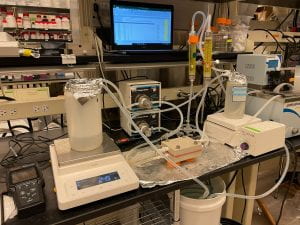
While the first week was mostly dedicated to the “how’s” of membrane distillation, the second week has been all about the “whys.” I learned a bunch more details about my project, membrane distillation, and am now better able to describe what’s actually going on.
Membrane distillation is a thermally driven method of purifying water that centers around a microporous hydrophobic membrane that only allows water vapor to go through, leaving dissolved particles on one side of the membrane called the feed, and purified water on the permeate side of the membrane. Currently Reverse Osmosis (RO) is the predominant method of water filtration globally. Membrane Distillation (MD) was originally proposed as a replacement to RO, however there would have to be significant advances in membrane technology for this to be the case. As it stands today, membrane distillation is thought to have more potential as a complement to RO, with potential limited uses on its own in areas with constant low-grade heat sources, like near chemical refineries for example. Reverse Osmosis generates a large amount of concentrated brine alongside the clean water, and how to deal with this brine is still under consideration. In coastal areas this brine can simply be pumped back into the ocean, however the subsequent increase in salinity poses an ecological risk. When inland, brine management becomes an even greater challenge. Each time the brine is run through a dedicated RO system, the processed brine becomes even more heavily concentrated. Membrane Distillation is well equipped to handle this super-concentrated solution, and can help achieve a wastewater management strategy of zero liquid discharge (ZLD). In this ideal scenario, all water can be processed ad infinitum, recycled in a closed loop with little to no waste.
One of the biggest challenges hindering the widespread adoption of membrane distillation is the issue of membrane fouling. Fouling is defined as a decline in flux from initial conditions and is caused by pore blockage, pore constriction, and cake formation. A “filter cake” is simply a buildup of particles which causes hydraulic resistance. Some fouling is considered “hydraulically reversible,” and can be cleared through backwashing the system the same way that RO membranes are purged. Pore blockage is far less hydraulically reversible than filter cake removal, and gradually degrades a membrane’s performance until it must be replaced. Reducing the amount of time between each necessary cleaning and replacement is the main focus of my project here.
My mentors and I will be working to reduce the fouling of the membranes used in membrane distillation by altering the feed temperatures, flow rates of the feed and permeate sides, keeping the membrane cell at various angles, and introducing microbubble aeration into the system.
Thank you for this post, Aislinn! Great explanation of MD and fouling!